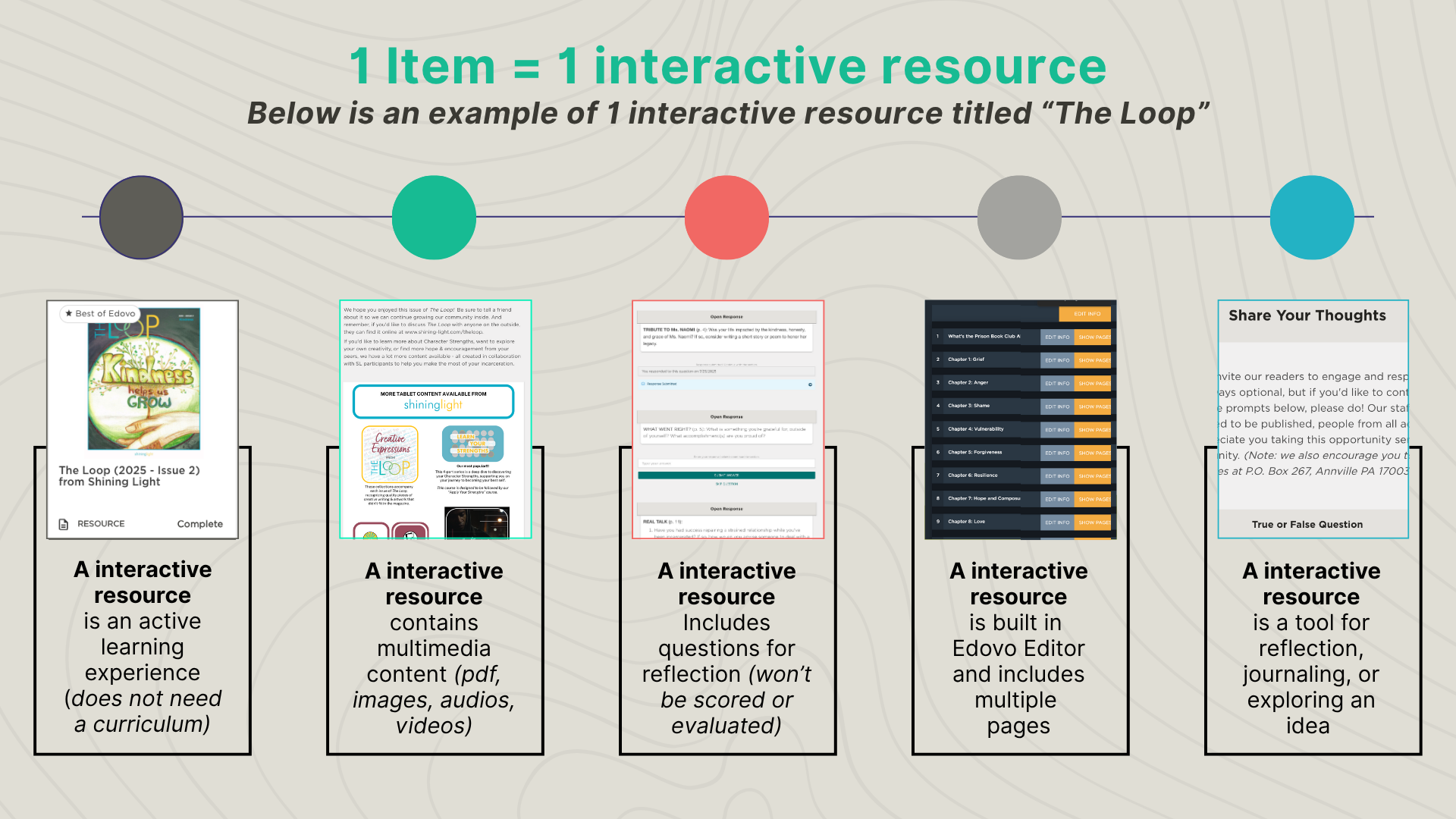A closer look at what an interactive resource is (and is not)
A flexible, lightweight way to create active learning experiences without building a full course.
Your cheat sheet for this article:
Interactive Resources are short-form, active learning experiences.
Built in the Edovo Editor and includes one or more interactive elements (like quizzes or open responses).
No certificate, no formal curriculum—but still shows up on a learner’s transcript.
Great for feedback, reflection, reinforcement, or bite-sized lessons.
So, what is an Interactive Resource?
Think of it as a course’s chill cousin—a little more casual, a little less structured, but still showing up and doing the work.
Interactive Resources are active learning experiences that:
Multimedia content delivered through the Edovo Editor
Include a do-something item: Learners engage through open-ended prompts or multiple choice questions.
May include multiple multimedia elements such as videos, audio clips, images, documents, or text—used to support learning, spark curiosity, or guide response.
choice questions (yes, even one counts!)Deliver standalone insight or invite feedback and reflection
Can be built with multimedia content—like PDFs, videos, or audio clips
A tool for reflection, journaling, or exploring an idea
A flexible, low-barrier way to invite interactivity and self-expression, not just deliver info
You get to include a:
Title (keep it under 70 characters, make it clear not clever)
Description (150–300 character punch at the top)
Icon (500px x 500px, no fine print, no clutter)
And just like a course, you can include:
An intro page
Multimedia items
Questions or prompts
A wrap-up message
But unlike a course:
There's no scoring
No certificates
And no locked sequence—you’re just delivering one quick interactive learning moment.
Use it when:
You’ve got a single concept you want learners to reflect on
You want to follow up on something passive (like a video or newsletter)
You want to ask questions or gather feedback without building a full survey
You want to make your content more engaging without committing to full curriculum design
Examples we love:
A 5-minute video followed by a reflection: “What part of this message stayed with you?”
A text resource with a quiz: “Check your understanding before moving on.”
A short prompt: “What advice would you give someone facing this choice?”
A mindfulness meditation followed by a journaling prompt like “What’s one moment today you want to let go of?”
A community resource guide with questions about next steps, goals, or support needs
A short story or article with a multiple-choice or open response reflection at the end
A digital magazine with open response questions prompting learners to write ideas for the next magazine topic.
 1 Item = 1 Interactive Resource
1 Item = 1 Interactive Resource
What It’s Not
A course with formal objectives, multiple lessons, and assessments (that’s the full buffet tray—we’ll cover it next)
A stand-alone resource (those are grab-and-go, no interaction required)
Purely informational or entertainment content with no questions—if there’s nothing for the learner to respond to, it should be a stand-alone resource
A sneaky way to dump a ton of files into one “item” to get more content published — interactive resources should be a thoughtful collection of files with an opportunity for learners to engage in some way.
TL;DR:
Interactive Resources are bite-sized, active learning moments built in the Edovo Editor. They're quick to create, impactful to engage with, and perfect for adding energy to your content without the formality of a course. No certificate, no problem. These short experiences still show up on a transcript—and they show your learner that their voice matters.
Your next read:
- What’s the difference between certificates and transcripts?
- One-way feedback strategies: How to gather and use learner feedback
- A practical guide to the Edovo Editor: How to build, preview, edit and publish active content
- Getting help with your active learning content creation: Edovo's professional services
- A practical guide to the Edovo Editor: How to build, preview, edit and publish active content
- The Edovo Edge: Research-backed methods for real results
Related Articles
A closer look at what a stand-alone resource is (and is not)
Because sometimes, less is more—and that’s the point. Overview Not everything needs to be a course. Or even an interactive experience. Sometimes, what learners need is something they can watch, read, or listen to—without being asked to answer ...A closer look at what a course is (and is not)
You’ve heard it before: “This could be a course!” But… could it really? On Edovo, “course” means something specific—and powerful. Before you start building, let’s get clear on what a course is (and what it’s definitely not). Your cheat sheet for this ...A closer look at what a survey is (and is not)
Surveys on Edovo are your go-to tool for hearing directly from learners. They're not about transferring knowledge. They're about receiving it. Your cheat sheet for this article A survey is a set of questions designed to gather insight—not deliver ...How to build active content in the Edovo Editor (courses and interactive resources)
How to build active content in the Edovo Editor (courses and interactive resources) Wondering, “Do I need to be a coder to use the Editor?”—breathe easy. You don’t. This article gives you the roadmap so you too can create active content in the Edovo ...Step 1: Choosing the right format for your content: Active vs. passive learning experiences
Start here: How do you want learners to engage? Before you choose a format, ask yourself one key question: How do I want learners to engage with my content? This guide breaks down the difference between active and passive learning—the two main ...